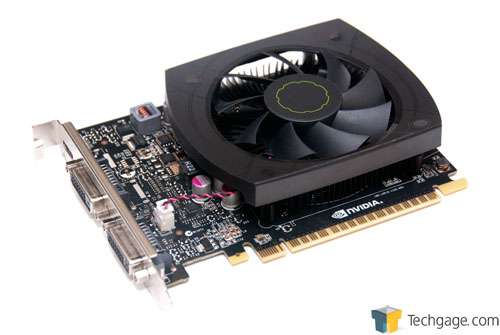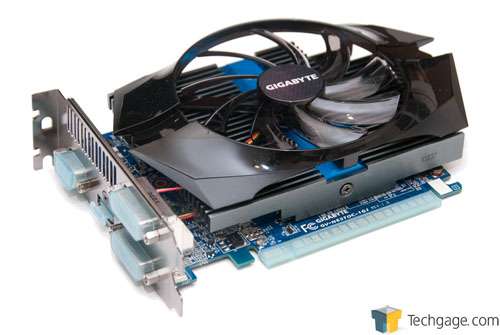- Qualcomm Launches Snapdragon 4 Gen 2 Mobile Platform
- AMD Launches Ryzen PRO 7000 Series Mobile & Desktop Platform
- Intel Launches Sleek Single-Slot Arc Pro A60 Workstation Graphics Card
- NVIDIA Announces Latest Ada Lovelace Additions: GeForce RTX 4060 Ti & RTX 4060
- Maxon Redshift With AMD Radeon GPU Rendering Support Now Available
GIGABYTE GeForce GTX 650 Ti 1GB Review

NVIDIA does such a great job filling holes in its product line-ups, that sometimes it manages to fill a void we didn’t even know existed. The GTX 650 Ti is a perfect example of this. This GK106-based card sits close to the GTX 660, and with GIGABYTE’s overclocked GV-N65TOC-1GI, we’ll see if we can close the gap even further.
Page 1 – Introduction
If there’s one thing NVIDIA cannot be accused of, it’s not giving its fans freedom of choice. More than any other GeForce generation in recent memory, the 600 series is truly packed to the gills with choice. We not only have proper steppings ranging from 610 up to 690, but sub-models in between, such as the “Ti” (Titanium) cards.
One such card is the one we’re looking at here, the GeForce GTX 650 Ti. This is a card that seemed unlikely to come to fruition simply by the fact that NVIDIA’s line-up was already so full. After the GTX 660 launch, I felt confident that that would be it until the 700 series – but no. It’s clear that NVIDIA both likes to remain in the limelight, and make sure people get exactly the card they’re looking for at the price they can afford.
The downside to all this is that the number of models NVIDIA offers can become overwhelming, quick. Take for example the fact that the GTX 650 Ti isn’t built on the same GK107 chip that the GTX 650 is. Instead, it’s built using GK106 – shared with the GTX 660. This results in a card that’s much closer to the GTX 660 than the GTX 650. As I mentioned upon the launch of the GTX 650, it was one card that shouldn’t have been released with the GTX moniker. To me, the GTX 650 Ti is what the GTX 650 should have been.
Let’s take a look at the 600-series table below to gain an understanding of the differences we’re dealing with:
| Cores | Core MHz | Memory | Mem MHz | Mem Bus | TDP | |
| GeForce GTX 690 | 3072 | 915 | 2x 2048MB | 6008 | 256-bit | 300W |
| GeForce GTX 680 | 1536 | 1006 | 2048MB | 6008 | 256-bit | 195W |
| GeForce GTX 670 | 1344 | 915 | 2048MB | 6008 | 256-bit | 170W |
| GeForce GTX 660 Ti | 1344 | 915 | 2048MB | 6008 | 192-bit | 150W |
| GeForce GTX 660 | 960 | 980 | 2048MB | 6000 | 192-bit | 140W |
| GeForce GTX 650 Ti | 768 | 925 | 1024MB | 5400 | 128-bit | 110W |
| GeForce GTX 650 | 384 | 1058 | 1024MB | 5000 | 128-bit | 64W |
| GeForce GT 640 | 384 | 900 | 2048MB | 5000 | 128-bit | 65W |
| GeForce GT 630 | 96 | 810 | 1024MB | 3200 | 128-bit | 65W |
| GeForce GT 620 | 96 | 700 | 1024MB | 1800 | 64-bit | 49W |
| GeForce GT 610 | 48 | 810 | 1024MB | 1800 | 64-bit | 29W |
The GTX 650 Ti doubles the core-count of the GTX 650, has a decreased core clock but increased memory clock. Compared to the GTX 660, it suffers the loss of 192 cores, slight clock reductions and a drop from 192-bit memory down to 128-bit -these cards need to be different, after all. Thanks to this table, it’s easy to understand why the GTX 650 Ti is much closer to the GTX 660 than the GTX 650.
As a middle-of-the-road card in NVIDIA’s 600-series, the reference model looks the part:
The card we’ve benchmarked is GIGABYTE’s GV-N65TOC-1GI, an overclocked model; boosting the core clock from 925MHz to 1032MHz but leaving the memory clock alone. This increases the price a bit (about $20), but as overclocks like this are not rare, you should be able to run a similar config if you pick up a reference-clocked model that has a sufficient cooler.
Given we had a reference model here, it was our intention to benchmark it alongside this GIGABYTE one, but it unfortunately died overnight one night preventing us from finishing-up our benchmarking. I’m not sure what caused it, but I don’t suspect it’s typical.
GIGABYTE’s card features a cooler similar to the reference, though with a larger heatsink and fan. It also looks considerably better as well, depending on your tastes. Unlike the reference model, it features a VGA and HDMI port in addition to dual DVIs. For much-improved cooling, GIGABYTE also offers a GV-N65TOC-2GI model, using a ‘WINDFORCE’ dual-fan cooler, retailing for about $175 (+$35 over most reference-styled models).
Support our efforts! With ad revenue at an all-time low for written websites, we're relying more than ever on reader support to help us continue putting so much effort into this type of content. You can support us by becoming a Patron, or by using our Amazon shopping affiliate links listed through our articles. Thanks for your support!







